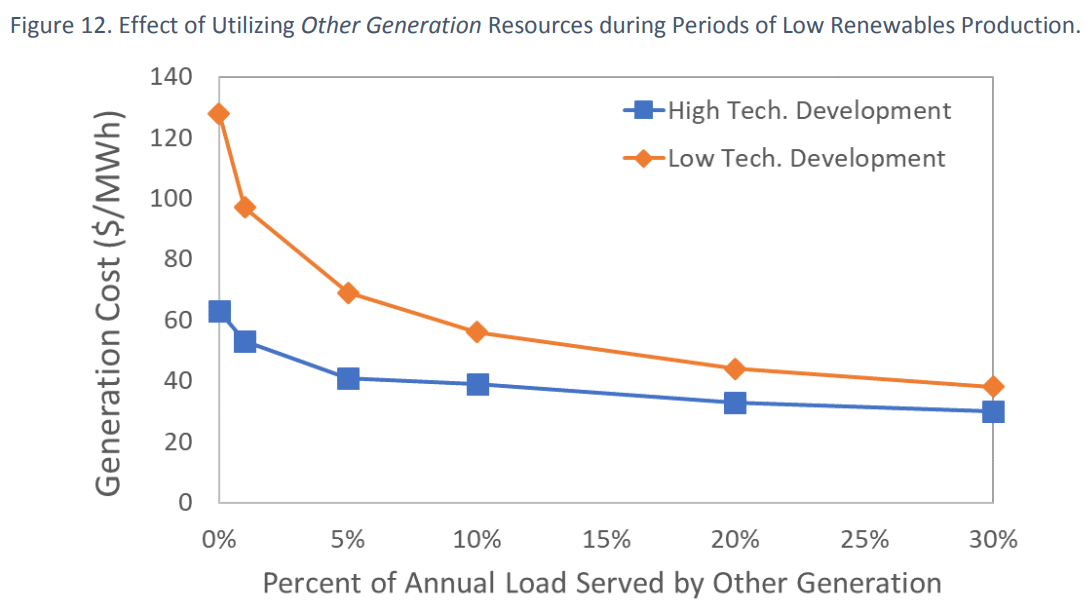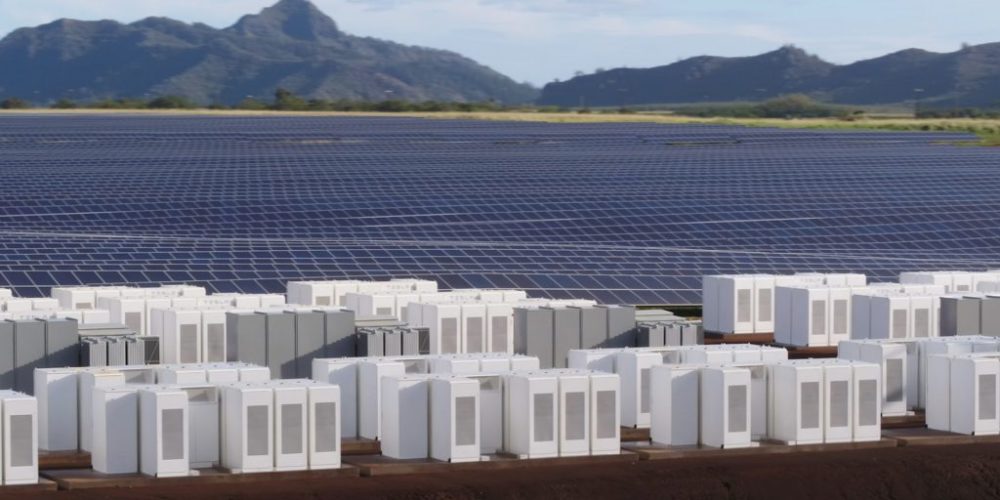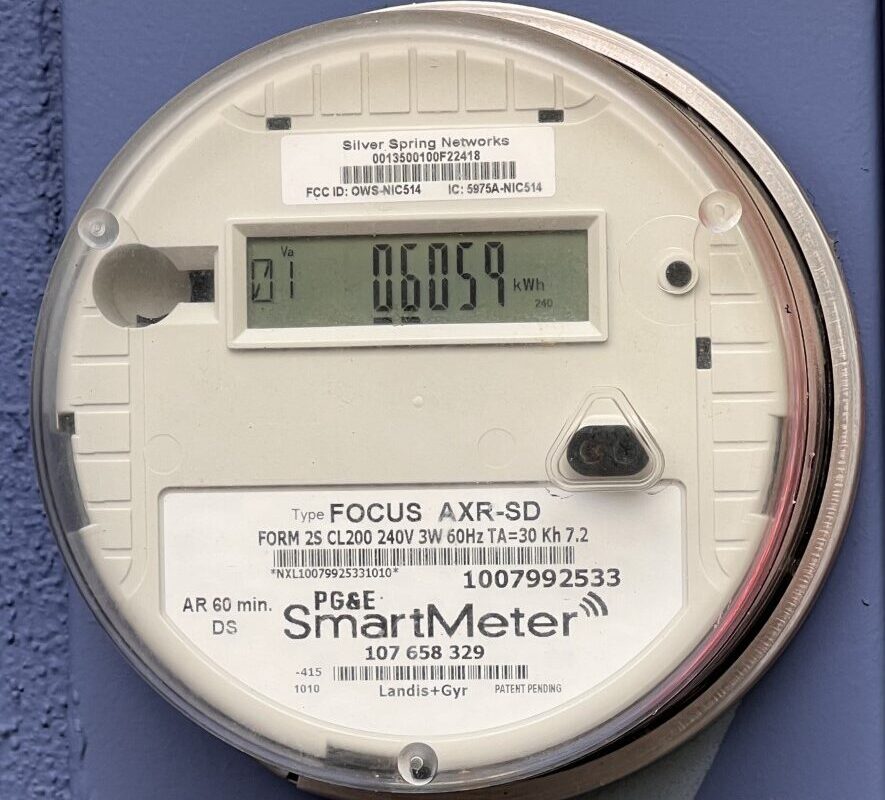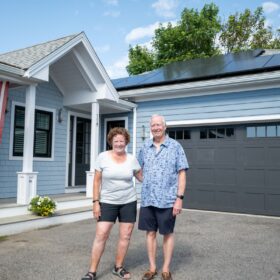In 1973, the University of Delaware built “Solar One” (MIT research paper on the experiment – pdf). Noted as one of the world’s first solar powered houses, it had a special meter that allowed it to export excess daytime electricity to the grid and purchase when it was needed. Today, the United States has more than 2 million individual solar power systems – and the question is no longer, if solar works – but how far can we go with it?
In a recent paper, Storage Requirements and Costs of Shaping Renewable Energy Toward Grid Decarbonization, researchers from MIT modeled the costs of energy storage needed to make a 100% wind plus solar power grid cost competitive with nuclear and gas. The research found that meeting baseload demand 100% of the time requires storage energy capacity costs below $20/kWh, and – much more importantly – when meeting baseload demand 95% of the time, the energy capacity cost target rises to $150/kWh (a 7.5X increase).
There are things to argue with in this paper, for instance, the document uses 7.5¢/kWh for the nuclear generated electricity with a 97.3% capacity factor. Lazard’s most recent cost comparisons relay that the levelized cost of electricity for nuclear is 11-19¢/kWh and the EIA is proud of recent capacity factor records for nuclear around 91-92%. However, the 95% of wind+solar is our focus today.
80% Renewables is Cake
The first thing that most folks in these “100% renewables” models tend to do is ignore that the United States gets 20% of its electricity from nuclear power and 10% from hydroelectric. So, why aren’t we talking about 70% renewables with hydroelectric as a flexible baseload with some amount of nuclear power (if it can figure out how to stay online)?
California is aiming for 60% renewables by 2030 and 100% carbon free by 2045, Maine 80% in the same year, New Mexico 50% by 2030 also with 100% “carbon free” by 2045 as well. All of these states made those judgment calls, at least partially, because their common sense suggests to them that maybe – just maybe – we’re going to have some of those resources still existing.
It is understandable why there are models showing the 100% wind+solar mix, and that’s mainly because it is a popular topic – and research papers are written based on subjects that get the attention of grant funders. But if we’re going to be academically honest, we need look much more closely at reality – and maybe take a cue from these politicians. Where are the 20% nuclear and 10% hydroelectric models?

One of this author’s favorite studies notes that the USA could potentially get to 80% wind+solar, without additional transmission powerlines, using 12 hours of energy storage. In the above image from the MIT paper (located in the tiny image in the middle of the bottom row), you can see that as the mix of wind and solar approaches 100% on the left, the price of electricity increases aggressively. Again, the paper notes that a decrease from 100% to 95% allows for an increase in energy storage cost from $20/kWh to $150/kWh. You can see that values due continue to decrease as 80% is reached, but most of that has occurred by 95%.
In a document prepared by Clean Power Research for the MN Solar Pathways Initiative, it was found that going forward oversizing wind and solar power, is actually cheaper than seasonal storage in Minnesota. However, deep within the document we were given another nugget – in the below image we see how using other sources of electricity generation for the final 30% decreases the cost of energy. Specifically, in Minnesota we see the same aggressive jump in the final 5% that the MIT researchers found.

And the grid can handle it. There have been a lot of researchers in the past who’ve suggested the power grid cannot handle these levels of intermittent electricity generation. Well, the world has shown that it can – at moments – handle up to 100% of electricity demand being met by wind and solar in various markets. In California this past spring, we had a moment of solar at 84% of the power grid. Recent research from NREL suggests that the Eastern Interconnect can handle 70% renewables over the course of the year.
The purpose of this article is to focus us. To focus the contractors and developers on building. To focus the scientists on developing the technologies at the end of the chain. To focus the grid operators on slowly ramping up wind and solar and storage, and vehicle to grid, and demand response. And to get the regulators thinking real hard about the realities of what is possible with the technologies we already have today.
Deploy, deploy and deploy.
This content is protected by copyright and may not be reused. If you want to cooperate with us and would like to reuse some of our content, please contact: editors@pv-magazine.com.








And this entire #RE80 positive analysis is based on current PV/Wind costs, yet at least PV cost is still significantly declining. Specifically, the DOE’s #SunShot2030 effort is to reduce PV LCOE another 50% from 2017’s costs (SunShot2020 goal met in 2017).
Therefore, the real story about PV and meeting #RE80/#RE100 goals is even WAY better!!
Your $/KWh should have been$/Mwh
Just in the past month or so, there have been articles stating projects that would generated power at around $38/MWh, then a month later another project is announced that would generate power at $31/MWh. The real answer is how fast and how low will it go?
Nice piece. I made the case for 80% renewables as the reasonable goal for the next couple of decades, in the US and globally, in my 2015 book Solar: Why Our Energy Future Is So Bright, and in a number of articles. Good to see people catching up 🙂
These studies continue to view energy resources from top down modeling. However a paradigm shift is occurring where top down supply is less and less relevant. Bottom up residential, c/i, military, community micro grid, iot /tos , and home battery/vehicle battery to home power systems are changing the broad landscape of user based solutions. Utilities that punish user based solutions are finding the expect policies that they meant to stop home energy Independence are hastening it. (See Hawaii as case study, especially interconnect denials give rise to battery off-grid rebellion)
Good article. It would be nice if we would start worrying about 50-80% RE before we worry about 100%. This is like worrying about how you are going to look breaking the tape at the end of the marathon 5 miles into it.
I think another reason there’s focus on meeting 100% capacity solely by wind+solar is specifically because it’s an expensive capability, making wind+solar seem less viable. These same folks post pictures of windmills catching fire, and point out that solar doesn’t work at night.
Finally, a common sense article!
Batteries will go down another 50% or so but the problem with that is all the necessary land coverage. Too bad gen 4 nuclear isn’t allowed!